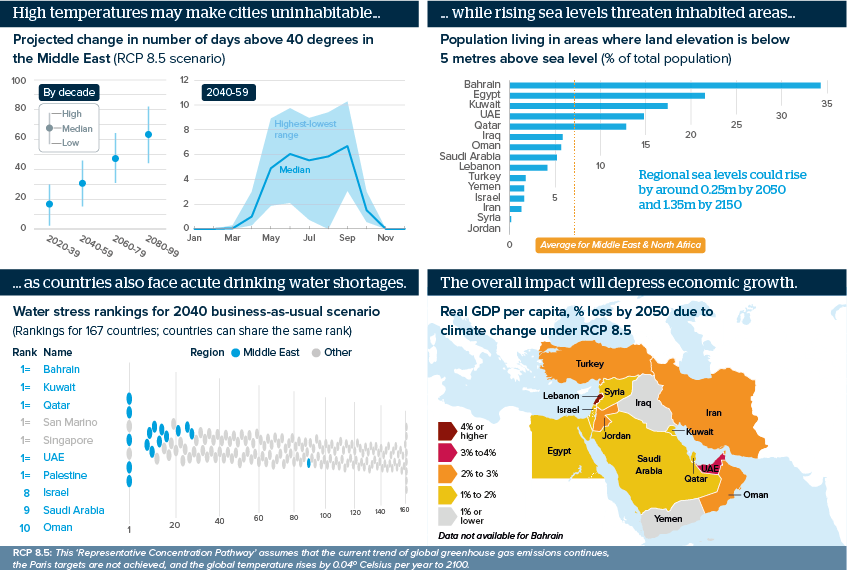Climate change poses many threats to the Middle East
Areas around the Gulf are especially vulnerable to extreme weather, spiking heat, freshwater shortages and flooding
Source: NASA EarthData, Sea Level Change; World Bank, World Development Indicators; World Resources Institute, Water Stress Rankings 2015; NBER paper ‘Long-Term Macroeconomic Effects of Climate Change: A Cross-Country Analysis’, August 2019, Universities of Cambridge, Southern California, Johns Hopkins, National Tsing Hua University and the IMF.
Outlook
Ahead of the international COP26 summit in Glasgow, the United Arab Emirates (UAE) committed to achieving net zero carbon emissions by 2050 -- an ambitious target for an expanding oil producer currently in the global top six, together with its Gulf Cooperation Council (GCC) neighbours.
The direct threat from higher temperatures is extreme, especially around the Gulf. Studies suggest that, in a scenario without mitigation, summer ‘wet bulb’ temperatures (combining measures of heat and humidity) in parts of the GCC, Yemen, Iraq and Iran could exceed the levels at which humans can cool their body temperatures through perspiration, leaving them effectively uninhabitable.
Impacts
- With more extreme weather events and sea levels rising, low-lying Gulf states like Bahrain and Nile Delta-dependent Egypt face flood risks.
- Water shortages and drought, especially in poorer and less stable places such as Yemen and the Palestinian territories, may drive conflict.
- Climate pressures will also have a negative impact on areas including farming, productivity and migration, sapping GDP growth.
- As the impacts of climate change are more directly felt and a youth constituency gains a voice, pressure could rise for radical action.
See also
- Flash floods will increase in frequency in the Gulf - Apr 26, 2024
- Competition over water may drive new crises in Iraq - May 31, 2023
- Jordan’s coming climate crisis will hit youth hard - Dec 13, 2021
- Gulf competition for green legitimacy may have impact - Oct 26, 2021
- Water scarcity will boost Turkey-Syria-Iraq tensions - Oct 6, 2021
- The Gulf will lag on climate action, despite exposure - Feb 12, 2020
- More graphic analysis
